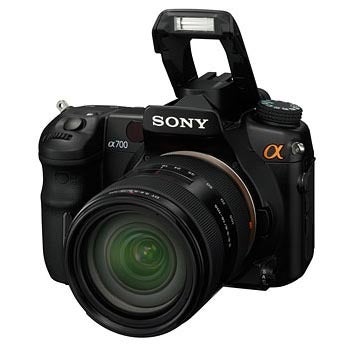The 10.2-megapixel Sony Alpha A200 replaces the two-year-old A100 with a number of subtle improvements including a larger LCD screen and increased sensitivity range.
Sony Alpha a200 Review
Features
10.2MP Sensor
Sensibly, Sony has stuck to the same 10.8MP total CCD sensor that featured in the A100, giving an effective pixel count of 10.2MP. Usually this is the first thing manufacturers like to boost in ‘upgraded’ models, but Sony has left this unchanged. Thanks to the 23.6 x 15.8mm APS-C format sensor, the focal length conversion factor of 1.5x has also remained.
Bionz Processor
Processing and operation are handled by Sony’s Bionz image processor, which is now said to be responsible for a 1.7x faster autofocusing system, as well as high speed image processing and a reduction in image noise. Noise is removed from Raw files before images are converted to JPEGs, theoretically minimising any effects that JPEG artefacts would have on it during compression.
Metering
The metering system uses a 40-segment honeycomb pattern, with the options of multi-segment, centre-weighted and spot. The camera’s sensitivity range has been extended, with an extra stop now at ISO 3200 and the option of Noise Reduction accompanying higher settings and longer exposures, while the nine-point focus system comprises eight selectable points and a central cross-hair sensor.
Image Stabilisation
Sony’s sensor-based Super SteadyShot image stabilisation technology has continued on the A200, claiming to allow shutter speeds of 2.5 to 3.5 steps slower than would usually be possible. Dust, meanwhile, is handled by a two-step process; utilising a static-free coating on the low pass filter and quick vibration of the sensor upon each powering off of the camera, to help prevent and shake off any dust that may have worked its way into the body.
Dynamic Range and Burst Rate
The D-range Optimiser features two settings said to help bring out detail in shadows and highlights. The first works on the image as a whole to assess brightness and contrast while the second analyses each area of the image separately to bring out detail.
The camera offers a 3fps burst rate in JPEG capture, with a six-frame limit for Raw images, three-frame limit for simultaneous Raw+JPEG recording, and unlimited capture for JPEGs, depending on the shooting parameters and the memory card used. Sony’s Creative Style settings, meanwhile, provide a choice of eight capture modes, including Standard, Vivid and Black & White modes, as well as an Adobe RGB setting.
Battery Improvements
The camera is powered by an Infolithium battery, which allows the camera to display its remaining power as a percentage and is claimed to allow up to 750 shots to be captured on a full charge. If this isn’t enough, an optional vertical grip launched alongside the model accepts two of the above cells, thus providing power for an extra 1,500 shots.
Other tweaks and improvements include a quieter shutter mechanism, higher X-sync speed when using Super SteadyShot (now from 1/125sec to 1/160sec) and the option to record images in 16:9 widescreen format





